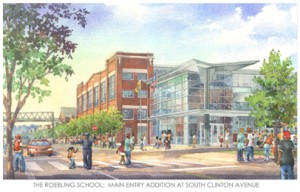The Roebling Community School
Winner: New Jersey Schools Construction; supporting partner: Trenton Public Schools
To the New Jersey Schools Construction Corporation for the Roebling Community School that will restore a historic factory building and contribute to the revitalization of the neighborhood.
Over the past 30 years, the City of Trenton has worked to transform the industrial area known as the Roebling complex into a catalyst for Trenton’s revitalization and growth. Although originally designed to produce steel wire rope used in suspension bridges (most notably the Brooklyn Bridge in New York and the Golden Gate Bridge in San Francisco), the buildings since have been recycled and converted into a variety of uses, including an arena, senior housing, museums, shops, offices, high-tech entertainment studios, and a rail transit hub. Within the next three years, one of the last unused sections of this historic complex will take new form and become a state-of-the-art 1,200-student public school facility.
The Roebling School project was made possible in large part by the landmark Abbott vs. Burke court case, in which the New Jersey Supreme Court mandated funding equivalent to the state’s top districts for 30 of the state’s special needs districts, of which Trenton is one. As a result of the decision, the state dedicated more than $8 billion dollars for new school construction statewide through the year 2010. The New Jersey Schools Construction Corporation (NJSCC), a subsidiary of the NJ Economic Development Authority (NJEDA), is in charge of producing and financing these new high-quality schools and school improvements.
The partnership between the NJSCC and the Trenton Public Schools has produced a building that, when complete, will provide educational space for 1,200 pre-kindergarten through 8th grade students in roughly 220,000 square feet of renovated and new construction on a 6.5-acre lot located in Trenton’s East Ward/Chambersburg neighborhood. The historically significant structures on the site will be saved and incorporated into the school and the less practical shed structures will be demolished to create appropriate spaces for courtyards, playgrounds, and parking.
The school has been deliberately designed to be mixed-use – it serves as both an educational and community facility that will be open to the public and provide a gathering place for local educational, social, political and athletic events. The buildings are divided so that entire sections of the school can be utilized by students or the public (gymnasium, cafeteria, kitchen, media center and computer classrooms) without intruding on the classroom areas.
By constructing the school in an existing urban area, the project protects other open lands that may have been used. The site is nearly 100 percent impervious surface (structures, asphalt and concrete paving) with only scrub weed growth. However, as part of the proposed project, substantial impervious surfaces will be removed and significant natural landscaping will be added including grass athletic play fields, permeable play surfaces at the Pre-K/K area, and trees and planters.
In addition to re-using the existing buildings, the Trenton School District has incorporated the building and site into the teaching curriculum by creating a special technology and history of technology program for its students. To that end, the interiors of the school will expose the historic cranes and salvaged machinery will be displayed throughout the corridors. The exterior courtyard space will incorporate historic factory fragments such as the rail lines, restored signage, and (secured) machinery to enhance the historic nature of the site. The tightly spaced concrete mushroom columns are celebrated in the first floor hallways, classrooms, and cafeteria, while the impressive steel trusses and skylights on the upper floors are playfully exposed in the media centers and corridors.
The project also fills in a void in the surrounding neighborhood. To the north, across Mott Street, and to the east, across Hudson Avenue, are residential row houses. The row houses have existed in that area prior to 1890 and were likely home to some of the original Roebling manufacturing workers. To the west of the property, across South Clinton Avenue, is the recently renovated Roebling Market – a retail shopping center and senior housing project developed by renovating several of Roebling’s other steel manufacturing buildings. The NJ Housing and Mortgage Finance Agency is in another former manufacturing building as well. The site is also within walking distance of two public parks – Washington Park and Columbus Park – which contain some athletic facilities. The Roebling School will balance the existing retail, commercial and office components, and transform what is currently a shadowy abandoned eyesore into an area where the streets will glow at night and hum with activity.
The state has recognized the transformative potential of this project and has named the Roebling School as the first of at least seven planned Renaissance School Zones. These zones are part of an initiative that combines smart growth ideals, school construction, and targeted state investment to spur private economic development in the neighborhoods around schools. The Roebling School offers a great example of what can happen when state agencies, local government and school districts work together toward a common vision – community enhancement and revitalization.
The result of this work will not only be a fully restored and preserved historic site, but also a unique community of learning for the children of Trenton. The design of the school has been featured as an outstanding work in progress in the Fall 2001 edition of “American School and University Journal” and the design also won a 2002 Silver Medal Award from the American Institute of Architects (NJ Chapter) design competition. It is the first Abbott Schools project to receive such an award. Construction of the school is expected to be complete in 2007.













